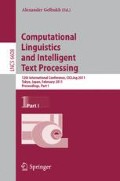Abstract
Currently, we can find a lot of weblogs written by young people. In the weblogs, they tend to describe their undiluted emotions or opinions. To analyze the emotions of young people and what causes those emotions, our study focuses on the specific Japanese language used among young people, which is called Wakamono Kotoba. The proposed method classifies Wakamono Kotoba into emotion categories based on superficial information and the descriptive texts of the words. Specifically, the method uses literal information used for Wakamono Kotoba, such as Katakana, Hiragana, and Kanji, etc., stroke count, and the difficulty level of the Kanji as features. Then we classified Wakamono Kotoba into emotion categories according to the superficial similarity between the word and the Wakamono Kotoba registered in the dictionary with an annotation of its emotional strength level. We also proposed another method to classify Wakamono Kotoba into emotion categories by using the co-occurrence relation between the words included in the descriptive text of the Wakamono Kotoba and the emotion words included in the existing emotion word dictionary. We constructed the Wakamono Kotoba emotion dictionary based on these two methods. Finally, the applications of the Wakamono Kotoba emotion dictionary are discussed.
Access this chapter
Tax calculation will be finalised at checkout
Purchases are for personal use only
Preview
Unable to display preview. Download preview PDF.
References
Nagata, M.: A Part of Speech Estimation Method for Japanese Unknown Words using a Statistical Model of Morphology and Context. In: Proceedings of ACL 1999, pp. 277–284 (1999)
Sasada, T., Mori, S., Kawahara, T.: Kana-Kanji Conversion by Using Unknown Word-Pronunciation Pairs with Contexts. Journal of Natural Language Processing 13(2), 131–153 (2010); The Association for Natural Language Processing
Asahara, M., Matsumoto, Y.: Japanese Unknown Word Identification by Character-based Chunking. In: Proceedings of the 20th International Conference on Computational Linguistics, pp. 459–465 (2004)
Nakagawa, T., Matsumoto, Y.: Guessing Parts-of-Speech of Unknown Words Using Global Information. In: Proceedings of the 21st International Conference on Computational Linguistics and the 44th Annual Meeting of the Association for Computational Linguistics(COLING/ACL 2006), pp. 705–712 (2006)
Kuwamoto, Y.: Production and Stability of Wakamono Kotoba. The Bulletin of Akita National College of Technology 38, 113–120 (2003)
Harada, T., Kameda, H.: Younger’s Word and their Processing Method. IEICE Technical Report 101(712), 17–24 (2002)
Matsumoto, K., Konishi, Y., Sayama, M., Ren, F.: Wakamono Kotoba Emotion Corpus and Its Application for Emotion Estimation. In: Proceedings of 2010 International Conference on Advanced Intelligence. Progress of Advanced Intelligence, vol. 2, pp. 89–99 (2010)
Plutchik, R.: The Emotion: Facts, Theories, and a New Model. Random House, New York (1962)
Yamaguchi, N.: Wakamono Kotoba ni Mimi wo Sumaseba. Kodansha publishers (2007)
Kitahara, Y.: Afureru Shingo. Taishukan Publisher (2009)
Yonekawa, A.: Wakamonogo wo Kagakusuru. Meiji Shoin (1998)
Winkler, W.E.: Overview of Record Linkage and Current Research Directions. Research Report Series (2006)
Kazama, J., Torisawa, K.: Inducing Gazetteers for Named Entity Recognition by Large-scale Clustering of Dependency Relations. In: Proceedings of ACL 2008: HLT, pp. 407–415 (2008)
Minato, J., Matsumoto, K., Ren, F., Kuroiwa, S.: Corpus-based Analysis of Japanese-English Emotional Expressions. In: Proceedings of IEEE NLP-KE 2007, pp. 413–418 (2007)
Matsumoto, K., Ren, F.: Estimation of Word Emotions Based on Part of Speech and Positional Information. Computers in Human Behavior (2010), doi:10.1016/j.chb.2010.10.028
Author information
Authors and Affiliations
Editor information
Editors and Affiliations
Rights and permissions
Copyright information
© 2011 Springer-Verlag Berlin Heidelberg
About this paper
Cite this paper
Matsumoto, K., Ren, F. (2011). Construction of Wakamono Kotoba Emotion Dictionary and Its Application. In: Gelbukh, A.F. (eds) Computational Linguistics and Intelligent Text Processing. CICLing 2011. Lecture Notes in Computer Science, vol 6608. Springer, Berlin, Heidelberg. https://doi.org/10.1007/978-3-642-19400-9_32
Download citation
DOI: https://doi.org/10.1007/978-3-642-19400-9_32
Publisher Name: Springer, Berlin, Heidelberg
Print ISBN: 978-3-642-19399-6
Online ISBN: 978-3-642-19400-9
eBook Packages: Computer ScienceComputer Science (R0)

